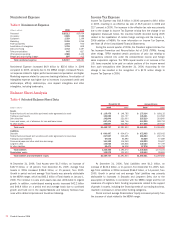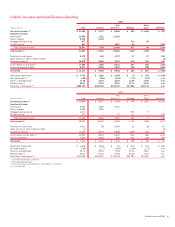Bank of America 2006 Annual Report Download - page 43
Download and view the complete annual report
Please find page 43 of the 2006 Bank of America annual report below. You can navigate through the pages in the report by either clicking on the pages listed below, or by using the keyword search tool below to find specific information within the annual report.Supplemental Financial Data
Table 6 provides a reconciliation of the supplemental financial data men-
tioned below with financial measures defined by accounting principles
generally accepted in the United States (GAAP). Other companies may
define or calculate supplemental financial data differently.
Operating Basis Presentation
In managing our business, we may at times look at performance excluding
certain nonrecurring items. For example, as an alternative to Net Income,
we view results on an operating basis, which represents Net Income
excluding Merger and Restructuring Charges. The operating basis of pre-
sentation is not defined by GAAP. We believe that the exclusion of Merger
and Restructuring Charges, which represent events outside our normal
operations, provides a meaningful year-to-year comparison and is more
reflective of normalized operations.
Net Interest Income – FTE Basis
In addition, we view Net Interest Income and related ratios and analysis
(i.e., efficiency ratio, net interest yield and operating leverage) on a FTE
basis. Although this is a non-GAAP measure, we believe managing the
business with Net Interest Income on a FTE basis provides a more accu-
rate picture of the interest margin for comparative purposes. To derive the
FTE basis, Net Interest Income is adjusted to reflect tax-exempt income on
an equivalent before-tax basis with a corresponding increase in Income
Tax Expense. For purposes of this calculation, we use the federal statutory
tax rate of 35 percent. This measure ensures comparability of Net Interest
Income arising from taxable and tax-exempt sources.
Performance Measures
As mentioned above, certain performance measures including the effi-
ciency ratio, net interest yield and operating leverage utilize Net Interest
Income (and thus Total Revenue) on a FTE basis. The efficiency ratio
measures the costs expended to generate a dollar of revenue, and net
interest yield evaluates how many basis points we are earning over the
cost of funds. Operating leverage measures the total percentage revenue
growth minus the total percentage expense growth for the corresponding
period. During our annual integrated planning process, we set operating
leverage and efficiency targets for the Corporation and each line of busi-
ness. We believe the use of these non-GAAP measures provides additional
clarity in assessing the results of the Corporation. Targets vary by year and
by business, and are based on a variety of factors including maturity of the
business, investment appetite, competitive environment, market factors,
and other items (e.g., risk appetite). The aforementioned performance
measures and ratios, earnings per common share (EPS), return on average
assets, and dividend payout ratio, as well as those measures discussed
more fully in the following paragraph, are presented in Table 6.
Return on Average Common Shareholders’ Equity,
Return on Average Tangible Shareholders’ Equity
and Shareholder Value Added
We also evaluate our business based upon return on average common
shareholders’ equity (ROE), return on average tangible shareholders’
equity (ROTE), and shareholder value added (SVA) measures. ROE, ROTE
and SVA utilize non-GAAP allocation methodologies. ROE measures the
earnings contribution of a unit as a percentage of the Shareholders’ Equity
allocated to that unit. ROTE measures the earnings contribution of the
Corporation as a percentage of Shareholders’ Equity reduced by Goodwill.
SVA is defined as cash basis earnings on an operating basis less a charge
for the use of capital. These measures are used to evaluate our use of
equity (i.e., capital) at the individual unit level and are integral components
in the analytics for resource allocation. We believe using SVA as a
performance measure places specific focus on whether incremental
investments generate returns in excess of the costs of capital associated
with those investments. In addition, profitability, relationship, and invest-
ment models all use ROE and SVA as key measures to support our overall
growth goal.
Bank of America 2006
41
























